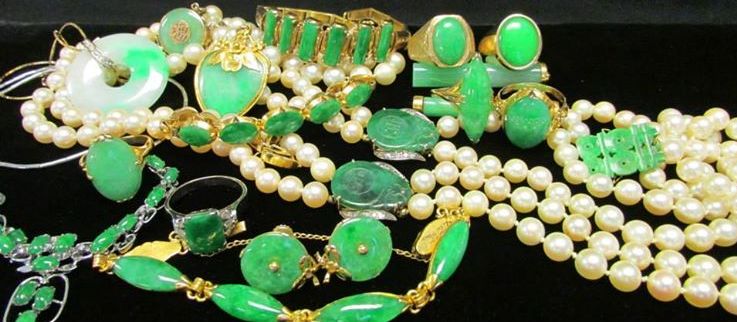
Little known to many jewelry buyers are the American River Pearls.
Natural, rare and valued throughout history, we have included some vintage jewelry that contains American River Pearls.
Sometimes called Mississippi River Pearls or Tennessee River Pearls, the pearls come in many shapes and sizes.
The river pearls that are normally used, are accents in jewelry pieces. These are normally smaller odd shaped baroque pearls.
Larger River Pearls are used as stand alone pieces in jewelry as in the previous photos.
A Brief History of the American River Pearl is from Wikipedia:
The “pearl rush” in North America occurred in the mid to late 1800s as people could easily find freshwater mussels in rivers and streams by “pollywogging” for mussels, some of which had freshwater pearls which they could sell for a significant price. The art of “pollywogging” involves shuffling one’s feet in the mud feeling around for freshwater mussels. Because this was relatively easy to do, and an easy way to make money from freshwater selling pearls, this period has been euphemistically called the “pearl rush”, and some historians have compared it to the gold rush in California.[13] A formal freshwater mussel fishing industry was established in the mid-1850s to take advantage of this natural resource.[14] The “pearl rush” to find freshwater pearls became so intense in some rivers that literally millions of freshwater mussels were killed in a few years. In some rivers and streams entire freshwater mussel beds were completely eliminated. Although the negative impact of the “pearl rush” on freshwater mussel populations was significant, in the cold light of history it was relatively minor compared to the over fishing that took place just a few years later with the “pearl” button industry.[13]
Freshwater pearls from North America come from freshwater mussels primarily in the family Unionidae. About 20 different species of Unionidae are commercially harvested for pearls. The common names of the most prolific pearl-bearing species include: the butterfly, ebony, elephant ear, heelsplitter, mapleleaf, three-ridge pigtoe, pimple back, pistol grip, and washboard. While white is the most common color, freshwater pearls are valued in part for their wide range of lustrous colors, including: blue, bronze, brown, copper, cream, green, lavender, pink, purple, red, salmon, silvery white, white, and yellow. The different colors of freshwater pearls are primarily a function of which species of freshwater mussel they were formed in, although various factors including position of the pearl nucleus in the shell, water quality, and species type all affect the color of the freshwater pearl.[14]

Freshwater Mussels that produce pearls
“Freshwater mussels” by Photo credit: Tim Menard / USFWS. USFWS Mountain-Prairie – Flickr: Mussel Species Survey Marais des Cygnes National Wildlife Refuge 2011. Licensed under CC BY 2.0 via Wikimedia Commons – http://commons.wikimedia.org/wiki/File:Freshwater_mussels.jpg#mediaviewer/File:Freshwater_mussels.jpg
By 1899, there were sixty button factories in the river states of Illinois, Iowa, Missouri, and Wisconsin, employing 1,917 people. Millions of “pearl” buttons were made annually. This new button industry quickly placed a huge ecological demand on the freshwater mussels of the Midwestern United States. In 1899, clammers harvested over sixteen million pounds of freshwater mussel shells in Wisconsin alone, and the harvest of freshwater mussels in the late 1890s numbered in the tens of millions of pounds per year. Freshwater mussels beds which had previously been so dense as to virtually “carpet” miles of river bottom were almost completely harvested, leaving just a few living freshwater mussel clams per mile. In 1908, in what was deemed a drastic response to the rapidly declining freshwater mussel population, the U.S. Bureau of Fisheries established a mussel propagation program at the Fairport Biological Station. The purpose of this program was to regulate the overharvesting of freshwater mussels. Freshwater mussels are slow growing sessile organisms, and their reproduction is complex. The button industry in North America was in trouble because years of over harvesting the freshwater mussels had caused a shortage of freshwater mussels and pushed many of the species close to extinction. The invention of plastic and its use in manufacturing buttons during World War II replaced shell “pearl” buttons as the most popular product, and foreshadowed the end of the pearl button manufacturing business.[11][12][13
America produces mussels that are still used for the nucleus in the cultured pearl production in Japan.
http://en.wikipedia.org/wiki/Unionoida
Most vintage river pearls are small added as accent pieces as shown below.
Hope you find a “Pearl” in your finds!
Happy Treasure Hunting This Weekend!
Sandy and Craig Watanabe
Aloha Memorabilia Company
www.alohamemorabilia.com





Please note: I reserve the right to delete comments that are offensive or off-topic.